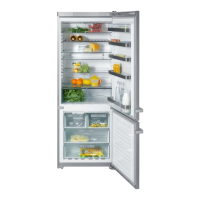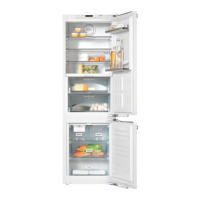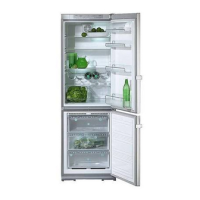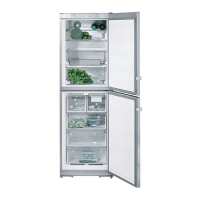Do you have a question about the Miele KTN 4352 SD ed and is the answer not in the manual?
Instructions for safe and responsible disposal of packaging materials.
Guidance on environmentally sound disposal of the old appliance.
Details on coolant safety, installation, and potential hazards.
Ensuring safe electrical connections and earthing according to regulations.
Precautions for handling frozen food and preventing frostbite.
Warnings on child safety, flammable materials, and preventing explosions.
Avoiding ventilation blockages and operating within climate limits.
Additional disposal safety, including making the appliance unusable.
Optimal placement for energy efficiency, considering environment and heat.
Guidance on setting thermostat temperatures for optimal energy consumption.
Tips on door use, food storage, and defrosting for energy efficiency.
Steps before first use, including initial standing time and powering on.
Procedures for switching off the appliance and preparing for extended periods.
Recommended temperature for long-term storage and freezing.
Recommended temperature for the refrigerator section.
How to use the control panel to set temperatures for both sections.
Understanding the indicator light for freezer temperature status.
Explanation of the alarm system's functions for temperature and door status.
How to manually stop or silence alarms if they are disruptive.
Benefits of quick freezing and how to activate Super Freeze.
Automatic switch-off and manual deactivation of the Super Freeze function.
How dynamic cooling improves air circulation and when to use it.
Understanding different temperature zones for optimal food placement.
List of items that should not be stored in the refrigerator.
Guidelines for packaging, hygiene, and preventing cross-contamination.
Tips for storing produce, considering gas emissions and interactions.
How to move and adjust shelves, split shelves, and bottle dividers.
Instructions for removing and repositioning door shelves.
Importance of adhering to the appliance's stated freezing capacity.
Advice on selecting foods, suitable packaging, and blanching.
Recommended materials and techniques for effective food packaging.
Proper arrangement for quick freezing and maintaining coldness.
Safe methods for defrosting various food types.
Instructions for filling, freezing, and removing ice cubes.
Warning about the duration for cooling drinks in the freezer.
Automatic defrosting for the refrigerator and condensate channel maintenance.
Explanation of the automatic defrosting in the freezer section.
Steps to take before cleaning, including power disconnection and food removal.
Detailed instructions for cleaning the appliance's interior, shelves, and parts.
Information on a special microfibre cloth for cleaning Miele appliances.
Maintenance of ventilation gaps and door seals for efficiency and longevity.
Dusting the heat exchanger grille for optimal performance.
Steps to take after cleaning to resume appliance operation.
Troubleshooting steps for cooling issues.
Solutions for an overly cold refrigerator section.
Diagnosing and resolving frequent or prolonged compressor operation.
Identifying causes for thawing food and a warm freezer.
How to gently separate food items that have frozen together.
Addressing the alarm sound and flashing indicator light issues.
Diagnosing why the Super freeze indicator light may not be functioning.
Steps for troubleshooting and replacing the refrigerator's interior light bulb.
Fixing a wet floor by clearing the drain hole.
Explanations for common sounds like humming, gurgling, and clicking.
Identifying and fixing unstable appliance parts or uneven leveling.
Information on how to get support and warranty service.
Requirements for safe mains connection and earthing in the UK.
Guidance on correct fuse replacement and plug safety.
Choosing a suitable installation site considering room temperature and ventilation.
Understanding the ambient temperature limits for appliance operation.
Ensuring proper air circulation by maintaining gaps around the appliance.
How to adjust the appliance's feet for stability and leveling.
Step-by-step guide to safely remove the door handle.
Instructions for disassembling the door and hinge components for swapping.
Reassembling the door and hinges on the opposite side.
Correctly reattaching door handles to prevent seal damage.
Spacing requirements for air circulation and door opening when integrated into cabinetry.
Instructions for safe and responsible disposal of packaging materials.
Guidance on environmentally sound disposal of the old appliance.
Details on coolant safety, installation, and potential hazards.
Ensuring safe electrical connections and earthing according to regulations.
Precautions for handling frozen food and preventing frostbite.
Warnings on child safety, flammable materials, and preventing explosions.
Avoiding ventilation blockages and operating within climate limits.
Additional disposal safety, including making the appliance unusable.
Optimal placement for energy efficiency, considering environment and heat.
Guidance on setting thermostat temperatures for optimal energy consumption.
Tips on door use, food storage, and defrosting for energy efficiency.
Steps before first use, including initial standing time and powering on.
Procedures for switching off the appliance and preparing for extended periods.
Recommended temperature for long-term storage and freezing.
Recommended temperature for the refrigerator section.
How to use the control panel to set temperatures for both sections.
Understanding the indicator light for freezer temperature status.
Explanation of the alarm system's functions for temperature and door status.
How to manually stop or silence alarms if they are disruptive.
Benefits of quick freezing and how to activate Super Freeze.
Automatic switch-off and manual deactivation of the Super Freeze function.
How dynamic cooling improves air circulation and when to use it.
Understanding different temperature zones for optimal food placement.
List of items that should not be stored in the refrigerator.
Guidelines for packaging, hygiene, and preventing cross-contamination.
Tips for storing produce, considering gas emissions and interactions.
How to move and adjust shelves, split shelves, and bottle dividers.
Instructions for removing and repositioning door shelves.
Importance of adhering to the appliance's stated freezing capacity.
Advice on selecting foods, suitable packaging, and blanching.
Recommended materials and techniques for effective food packaging.
Proper arrangement for quick freezing and maintaining coldness.
Safe methods for defrosting various food types.
Instructions for filling, freezing, and removing ice cubes.
Warning about the duration for cooling drinks in the freezer.
Automatic defrosting for the refrigerator and condensate channel maintenance.
Explanation of the automatic defrosting in the freezer section.
Steps to take before cleaning, including power disconnection and food removal.
Detailed instructions for cleaning the appliance's interior, shelves, and parts.
Information on a special microfibre cloth for cleaning Miele appliances.
Maintenance of ventilation gaps and door seals for efficiency and longevity.
Dusting the heat exchanger grille for optimal performance.
Steps to take after cleaning to resume appliance operation.
Troubleshooting steps for cooling issues.
Solutions for an overly cold refrigerator section.
Diagnosing and resolving frequent or prolonged compressor operation.
Identifying causes for thawing food and a warm freezer.
How to gently separate food items that have frozen together.
Addressing the alarm sound and flashing indicator light issues.
Diagnosing why the Super freeze indicator light may not be functioning.
Steps for troubleshooting and replacing the refrigerator's interior light bulb.
Fixing a wet floor by clearing the drain hole.
Explanations for common sounds like humming, gurgling, and clicking.
Identifying and fixing unstable appliance parts or uneven leveling.
Information on how to get support and warranty service.
Requirements for safe mains connection and earthing in the UK.
Guidance on correct fuse replacement and plug safety.
Choosing a suitable installation site considering room temperature and ventilation.
Understanding the ambient temperature limits for appliance operation.
Ensuring proper air circulation by maintaining gaps around the appliance.
How to adjust the appliance's feet for stability and leveling.
Step-by-step guide to safely remove the door handle.
Instructions for disassembling the door and hinge components for swapping.
Reassembling the door and hinges on the opposite side.
Correctly reattaching door handles to prevent seal damage.
Spacing requirements for air circulation and door opening when integrated into cabinetry.











